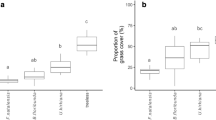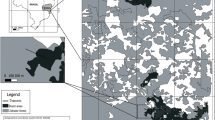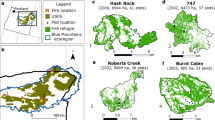Abstract
Seed dispersal and seedling establishment are essential for plant recolonization after disturbances, especially for plants that rely exclusively on sexual reproduction such as post-fire colonizer trees. Fire refugia may play a key role not only allowing trees to survive fire, but also functioning as seed sources after it. The estimation of seed dispersal and seedling establishment are essential for assessing plant recolonization ability, understanding landscape dynamics and determining which areas may not be able to recover due to lack of seed arrival. Here we study the post-fire recolonization ability of Austrocedrus chilensis (Cordilleran Cypress) from fire refugia in burned areas of northwest Patagonia, Argentina. We mapped all female trees, saplings and seedlings within and around fire refugia, recorded the reproductive capacity of female trees and characterized the microsite conditions for establishment. We used an inverse modelling approach and Approximate Bayesian Computation to estimate the seed dispersal kernel and the probability of seedling establishment. We found that the average dispersal distance of an A. chilensis seed was 88.52 m. The dispersal kernel was fat-tailed, meaning that A. chilensis has the capacity of producing accelerating expansions. Large woody debris, litter, and the protection of shrubs were the most important factors associated with the presence of recruits. We highlight the importance of fire refugia as seed sources for the recolonization of burned areas and thus the relevance of protecting these places to allow the persistence of fire-sensitive species.


Similar content being viewed by others
References
Beaumont MA (2010) Approximate Bayesian computation in evolution and ecology. Ann Rev Ecol Evol Syst 41:1
Bowman DM, Williamson GJ, Prior LD, Murphy BP (2016) The relative importance of intrinsic and extrinsic factors in the decline of obligate seeder forests. Glob Ecol Biogeogr 25(10):1166–1172
Bran D, Ayesa J, López C, Sbriller D (1996) Evaluación del área afectada por el incendio de enero de 1996 en Co Catedral Laboratorio de Teledetección Aplicada, INTA EEA Bariloche
Brión C, Grigera D, Rosso P (1993) The reproduction of Austrocedrus chilensis (D. Don) Florin et Boutleje Comptes rendus de l’Académie des sciences Série 3. Sciences de la vie 316:721–724
Camp A, Oliver C, Hessburg P, Everett R (1997) Predicting late-successional fire refugia pre-dating European settlement in the Wenatchee Mountains. For Ecol Manage 95:63–77
Canham CD, Uriarte M (2006) Analysis of neighborhood dynamics of forest ecosystems using likelihood methods and modeling. Ecol Appl 16(1):62–73
Castro J, Allen CD, Molina-Morales M et al (2011) Salvage logging versus the use of burnt wood as a nurse object to promote post-fire tree seedling establishment. Restor Ecol 19(4):537–544
Clark JS (1998) Why trees migrate so fast: confronting theory with dispersal biology and the paleorecord. Am Nat 152:204–224
Clark JS, Fastie C, Hurtt G et al (1998a) Reid’s paradox of rapid plant migration dispersal theory and interpretation of paleoecological records. Bioscience 48:13–24
Clark JS, Macklin E, Wood L (1998b) Stages and spatial scales of recruitment limitation in southern Appalachian forests. Ecol Monogr 68:213–235
Clark JS, Beckage B, Camill P et al (1999a) Interpreting recruitment limitation in forests. Am J Bot 86:1–16
Clark JS, Silman M, Kern R, Macklin E, HilleRisLambers J (1999b) Seed dispersal near and far: patterns across temperate and tropical forests. Ecology 80:1475–1494
Coop JD, Schoettle AW (2009) Regeneration of Rocky Mountain bristlecone pine (Pinus aristata) and limber pine (Pinus flexilis) three decades after stand-replacing fires. For Ecol Manage 257(3):893–903
Enright NJ, Fontaine JB, Bowman DM, Bradstock RA, Williams RJ (2015) Interval squeeze: altered fire regimes and demographic responses interact to threaten woody species persistence as climate changes. Front Ecol Environ 13:265–272
Gobbi M, Schlichter T (1998) Survival of Austrocedrus chilensis seedlings in relation to microsite conditions and forest thinning. For Ecol Manage 111:137–146
Gowda JH, Kitzberger T, Premoli A (2012) Landscape responses to a century of land use along the northern Patagonian forest-steppe transition. Plant Ecol 213:259–272
Haire SL, Coop JD, Miller C (2017) Characterizing spatial neighborhoods of refugia following large fires in Northern New Mexico USA land 6(1):19
Hartig F, Calabrese JM, Reineking B, Wiegand T, Huth A (2011) Statistical inference for stochastic simulation models-theory and application. Ecol Lett 14:816–827
Holz A, Wood SW, Veblen TT, Bowman DM (2015) Effects of high-severity fire drove the population collapse of the subalpine Tasmanian endemic conifer Athrotaxis cupressoides. Glob Change Biol 21:445–458
Johnstone JF, Allen CD, Franklin JF (2016) Changing disturbance regimes, ecological memory, and forest resilience. Front Ecol Environ 14(7):369–378
Katul GG, Porporato A, Nathan R et al (2005) Mechanistic analytical models for long-distance seed dispersal by wind. Am Nat 166:368–381
Keeton WS, Franklin JF (2005) Do remnant old-growth trees accelerate rates of succession in mature Douglas-fir forests? Ecol Monogr 75:103–118. https://doi.org/10.1890/03-0626
Kemp KB, Higuera PE, Morgan P (2016) Fire legacies impact conifer regeneration across environmental gradients in the US Northern Rockies. Landscape Ecol 31:619–636. https://doi.org/10.1007/s10980-015-0268-3
Keppel G, Wardell-Johnson GW (2012) Refugia: keys to climate change management. Glob Change Biol 18(8):2389–2391
Kitzberger T (1994) Fire regime variation along a northern Patagonian forest-steppe gradient: stand and landscape response. Dissertation, University of Colorado Boulder, Boulder
Kitzberger T, Veblen TT (1999) Fire-induced changes in northern Patagonian landscapes. Landsc Ecol 14:1–15. https://doi.org/10.1023/a:1008069712826
Kitzberger T, Steinaker DF, Veblen TT (2000) Effects of climatic variability on facilitation of tree establishment in northern Patagonia. Ecology 81:1914–1924
Kolden CA, Lutz JA, Key CH, Kane JT, van Wagtendonk JW (2012) Mapped versus actual burned area within wildfire perimeters: characterizing the unburned. For Ecol Manage 286:38–47
Kolden CA, Bleeker TM, Smith A, Poulos HM, Camp AE (2017) Fire effects on historical wildfire refugia in contemporary wildfires forests 8(10):400
Kot M, Lewis MA, van den Driessche P (1996) Dispersal data and the spread of invading organisms. Ecology 77:2027–2042
Krawchuk MA, Haire SL, Coop J et al (2016) Topographic and fire weather controls of fire refugia in forested ecosystems of northwestern North America Ecosphere. https://doi.org/10.1002/ecs2.1632
Landesmann JB, Gowda JH, Garibaldi LA, Kitzberger T (2015) Survival, growth and vulnerability to drought in fire refuges: implications for the persistence of a fire-sensitive conifer in northern Patagonia. Oecologia 179:1111–1122. https://doi.org/10.1007/s00442-015-3431-2
Leonard SW, Bennett AF, Clarke MF (2014) Determinants of the occurrence of unburnt forest patches: potential biotic refuges within a large, intense wildfire in south-eastern Australia. For Ecol Manage 314:85–93
LePage PT, Canham CD, Coates KD, Bartemucci P (2000) Seed abundance versus substrate limitation of seedling recruitment in northern temperate forests of British Columbia. Can J For Res 30:415–427
Letourneau FJ, Andenmatten E, Schlichter T (2004) Effect of climatic conditions and tree size on Austrocedrus chilensis–shrub interactions in northern Patagonia. For Ecol Manage 191:29–38
MaF Urretavizcaya, Defossé GE (2004) Soil seed bank of Austrocedrus chilensis (D. Don) Pic. Serm. et Bizarri related to different degrees of fire disturbance in two sites of southern Patagonia, Argentina. For Ecol Manage 187:361–372
McElreath R (2015) Statistical rethinking: a Bayesian course with examples in R and Stan. Chapman and Hall–CRC, Boca Raton
Nathan R (2006) Long-distance dispersal of plants. Science 313(5788):786–788
Nathan R, Muller-Landau HC (2000) Spatial patterns of seed dispersal, their determinants and consequences for recruitment. Trends Ecol Evol 15:278–285
Nathan R, Safriel UN, Noy-Meir I (2001) Field validation and sensitivity analysis of a mechanistic model for tree seed dispersal by wind. Ecology 82(2):374–388
Nathan R, Katul GG, Horn HS et al (2002) Mechanisms of long-distance dispersal of seeds by wind. Nature 418:409–413
Nathan R, Katul GG, Bohrer G et al (2011) Mechanistic models of seed dispersal by wind. Theor Ecol 4:113–132
Nuñez CI, Rovere AE (2005) Dimorfismo sexual en el Ciprés de la Cordillera. Patagonia Forestal 11:5–6
Nuñez CI, Raffaele E, Nuñez MA, Cuassolo F (2009) When do nurse plants stop nursing? Temporal changes in water stress levels in Austrocedrus chilensis growing within and outside shrubs. J Veg Sci 20:1064–1071
Ordóñez JL, Retana J, Espelta JM (2005) Effects of tree size, crown damage, and tree location on post-fire survival and cone production of Pinus nigra trees. For Ecol Manage 206:109–117
Ouarmim S, Asselin H, Hély C, Bergeron Y, Ali AA (2014) Long-term dynamics of fire refuges in boreal mixedwood forests. J Quat Sci 29(2):123–129
Padilla FM, Pugnaire FI (2006) The role of nurse plants in the restoration of degraded environments. Front Ecol Environ 4(4): 196–202
Pausas JG, Keeley JE (2014) Evolutionary ecology of resprouting and seeding in fire-prone ecosystems. New Phytol 204:55–65
R-Core-Team (2013) R: a language and environment for statistical computing. R Foundation for Statistical Computing, Vienna
Raffaele E, Veblen TT (1998) Facilitation by nurse shrubs of resprouting behavior in a post-fire shrubland in northern Patagonia, Argentina. J Veg Sci 9:693–698. https://doi.org/10.2307/3237287
Ribbens E, Silander JA, Pacala SW (1994) Seedling recruitment in forests: calibrating models to predict patterns of tree seedling dispersion. Ecology 75:1794–1806
Rovere A, Gobbi M, Relva A (2005) Regeneración de Austrocedrus chilensis. In: Arturi MF, Frangi JL, Goya JF (eds) Ecología y manejo de bosques de la Argentina. Editorial de la Universidad Nacional de La Plata, La Plata, pp 1–16
Salguero J (2000) Informe sobre las consecuencias ecológicas de los incendios forestales. APN, Delegación Regional Patagonia, Ecología del Fuego
Schurr FM, Bond WJ, Midgley GF, Higgins SI (2005) A mechanistic model for secondary seed dispersal by wind and its experimental validation. J Ecol 93(5):1017–1028
Schurr FM, Steinitz O, Nathan R (2008) Plant fecundity and seed dispersal in spatially heterogeneous environments: models, mechanisms and estimation. J Ecol 96:628–641
Souto CP, Kitzberger T, Arbetman MP, Premoli AC (2015) How do cold-sensitive species endure ice ages? Phylogeographic and paleodistribution models of postglacial range expansion of the mesothermic drought-tolerant conifer Austrocedrus chilensis. New Phytol 208:960–972
Stan Development Team (2018). RStan: the R interface to Stan. R package version 2.17.3. http://mc-stan.org/
Veblen TT, Lorenz DC (1988) Recent vegetation changes along the forest/steppe ecotone of northern Patagonia. Ann Assoc Am Geogr 78:93–111
Wood SW, Murphy BP, Bowman DM (2011) Firescape ecology: how topography determines the contrasting distribution of fire and rain forest in the south-west of the Tasmanian Wilderness World Heritage Area. J Biogeogr 38:1807–1820
Acknowledgement
This study was funded by Grant PIA (Proyectos de Investigación Aplicada) 12055. J.B. Landesmann acknowledges a National Scientific and Technical Research Council (CONICET) and a Bunge & Born Foundation fellowship. We thank Thomas Kitzberger and Juan Gowda for suggestions at initial stages of the work. We are also grateful to two anonymous reviewers that helped in improving the manuscript.
Author information
Authors and Affiliations
Corresponding author
Ethics declarations
Conflict of interest
The authors declare that they have no conflict of interest.
Additional information
Communicated by Joy Nystrom Mast.
Electronic supplementary material
Below is the link to the electronic supplementary material.
11258_2018_808_MOESM1_ESM.pdf
Online Resource 1. Supplementary figures showing the spatial representation of the location of all A. chilensis female trees, saplings and seedlings for all study sites (Figure A1); density functions for the scale (u) and shape (p) parameters from the seed dispersal kernel, and the probability density for the female reproductive capacity parameter (b) (Figure A2); priors and estimated posteriors for the substrate and protection of recruits (Figure A3). Supplementary material 1 (PDF 475 kb)
11258_2018_808_MOESM2_ESM.pdf
Online Resource 2. Detailed script for parameter estimates of seed production, seed dispersal and establishment using Approximate Bayesian Computation (ABC). Supplementary material 2 (PDF 428 kb)
Rights and permissions
About this article
Cite this article
Landesmann, J.B., Morales, J.M. The importance of fire refugia in the recolonization of a fire-sensitive conifer in northern Patagonia. Plant Ecol 219, 455–466 (2018). https://doi.org/10.1007/s11258-018-0808-4
Received:
Accepted:
Published:
Issue Date:
DOI: https://doi.org/10.1007/s11258-018-0808-4




